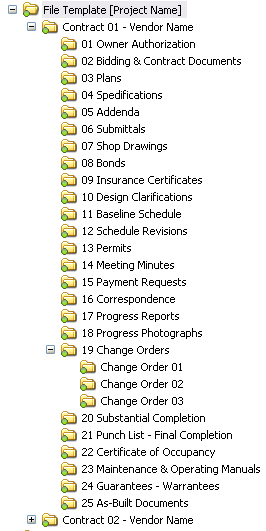Structure Better Projects: The Duty of Construction Document Management in Success
Structure Better Projects: The Duty of Construction Document Management in Success
Blog Article
Getting Seamless Project Delivery: Engineer's Comprehensive Technique to Construction Document Management
In the realm of design and construction, the thorough orchestration of job elements is extremely important to success. One critical facet often ignored is the administration of building papers, which acts as the backbone of every job. construction document management. As architects browse the intricacies of sychronisation, execution, and layout, a thorough technique to document administration becomes a cornerstone for accomplishing seamless project shipment. By exploring the nuances of this procedure, revealing the crucial aspects, and checking out cutting-edge technical services, architects introduce a path in the direction of enhanced effectiveness and cooperation within project groups. The combination of accuracy, modern technology, and collaboration creates the foundation of a successful architectural endeavor, elevating the significance of a structured paper management technique.
Significance of Building Record Administration
Effective construction document management plays a vital function in making certain job success by assisting in smooth interaction and organization throughout the building procedure. By maintaining up-to-date and exact building and construction documents, designers can properly communicate with service providers, subcontractors, and other stakeholders associated with the job. These records work as a recommendation point for all celebrations, making sure that everybody is functioning from the exact same set of information and minimizing the probability of misconceptions or errors.
Moreover, construction record management helps architects stay arranged by giving a central location for all project-related details, including illustrations, specs, contracts, and document. When needed, this company improves the decision-making procedure and permits for quick accessibility to essential job information. Additionally, proper record management can improve project effectiveness, reduce expensive hold-ups, and inevitably bring about the successful completion of construction projects. Designers who focus on building record management set a solid foundation for job success and show a dedication to supplying premium results.
Trick Elements for Efficient Paperwork

Offered the important duty that accurate and organized building paperwork plays in guaranteeing project success, it is vital to recognize crucial elements that add to efficient paperwork management. Firstly, clear and succinct interaction is extremely important. All stakeholders need to recognize the documentation demands and have the ability to accessibility and analyze the information conveniently. Secondly, establishing standardized layouts and procedures ensures consistency across all task documents. This consists of naming conventions, documents structures, and modification control to stop mistakes and confusion. Third, routine evaluations and updates are vital to maintain documents reflective and current of the project's progression. This practice aids recognize any kind of discrepancies or adjustments that need to be attended to immediately. Last but not least, applying a robust file monitoring system that enables for version control, access restrictions, and audit trails substantially boosts the company and security of project documents. By incorporating these crucial elements into building and construction document management techniques, designers can simplify processes, reduce mistakes, and ultimately contribute to the effective shipment of projects.
Using Modern Technology for Paper Organization
Leveraging advanced electronic devices and software application systems contributes in boosting the organization and ease of access of construction documentation. Architectural companies can simplify their file monitoring processes by applying specialized software program developed for the building and construction sector. These devices supply features such as variation control, cloud storage space, and collaborative editing and enhancing abilities, allowing team members to deal with files concurrently and making sure every person has accessibility to one of the most up-to-date details.
One key benefit of using technology for document company is the capacity to produce a centralized repository for all project-related documents. By keeping files in a safe electronic environment, engineers can quickly look, get, and share information with stakeholders, lowering the danger of version conflicts or lost documents. Additionally, advanced software program options typically incorporate metadata tagging and indexing functionalities, allowing users to categorize files successfully and retrieve them rapidly when needed.
Collaborative Strategies With Project Groups
To optimize job end results, engineers should welcome collective methods when collaborating with job groups to guarantee seamless communication and control throughout the construction process. Collaboration with project teams is important for engineers to effectively manage building tasks. my blog construction document management. By cultivating open interaction and team effort among all stakeholders, engineers can improve decision-making procedures, address prospective problems proactively, and make sure that every person is aligned with the project goals
Designers should develop clear lines of communication with engineers, service providers, clients, and various other key staff member from the beginning of the project. Regular conferences, progression updates, and responses sessions must be set up to keep everybody informed and engaged. Using collaborative task administration tools can likewise facilitate real-time details sharing and file partnership, improving openness and efficiency.

Best Practices for Document Variation Control

Conclusion
To conclude, efficient building file monitoring is crucial for achieving smooth task distribution. By concentrating on key elements such as organization, variation, and partnership control, engineers can ensure that all job groups are functioning from accurate and up-to-date details. Making use of modern technology can enhance the paperwork process and enhance general task efficiency. It is imperative for designers to implement finest techniques in file administration to successfully navigate the intricacies of building click this jobs.
Reliable building document management plays a critical duty in guaranteeing job success by helping with smooth communication and company throughout the building and construction procedure. In addition, proper paper management can enhance project effectiveness, reduce expensive delays, and inevitably lead to the successful completion of building and construction projects.To enhance job end results, engineers have to accept collective strategies when working with project groups to ensure seamless interaction and control throughout the building process. Collaboration with project groups is vital for architects to properly manage building projects.In the realm of collective construction job administration, maintaining specific control over paper versions stands as a crucial technique for ensuring task honesty and communication.
Report this page